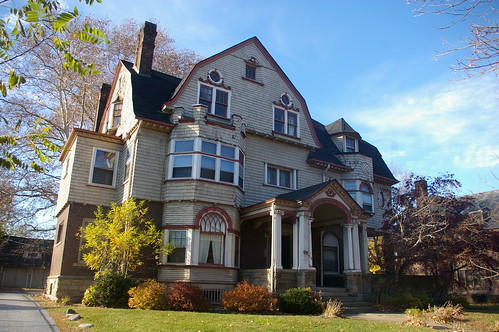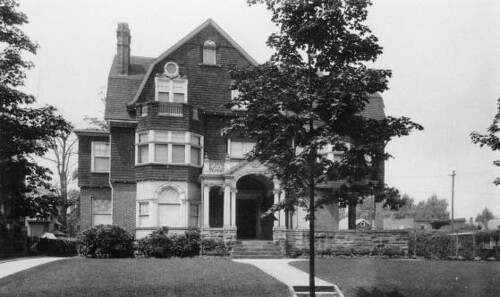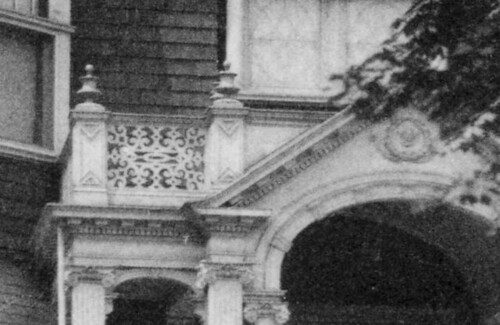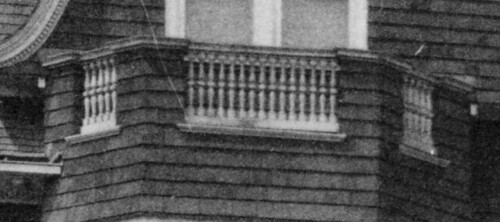
Back in November I posted a piece on the East 89th Street Historic District, a National Register of Historic Places Historic District, in Cleveland, Ohio. I lead with a picture of this house. At time, I referred to it simply as 1834 East 89th Street. Imagine my delight when I came across the following photo in Art Work of Cleveland (1911) in the Cleveland Public Library digital image collections.

It is surprising how little the house has changed in the past hundred years. Usually, it is difficult to maintain a house with this level of detail. If we look closely at the photograph, there are only two areas where significant changes are obvious.

Over the front entryway, an ornate railing was originally present.

A more simple railing was also present on the third floor, over the "tower".
It seems likely that these two railings were removed due to difficulty of maintenance and decay.

Overall, as mentioned above, the house is remarkably well preserved. Even the downspouts for the gutters are in the same location as the originals.
The above citation, by listing the owner at the time of the pubication, gives us a start in learning something of the history of the house.
According to the Cleveland Necrology File, Edward F. Dyer, born in 1859, died in this house at 9 AM on Monday, May 7, 1923. He is buried in Lakeview Cemetery. He was the father of Herrick (or Harold) H. Dyer.
Edward F. Dyer was the son of Ebenezer Herrick Dyer, who established the first commercially viable sugar beet mill in the United States. A historical marker in Union City, California, commemorates the site of the factory, on Byer's farm. Edward would go on to be an inventor and engineer for his father's company.
The Builders of a Great City: San Francisco's Representative Men states "To the perseverance and pluck of Mr. Dyer, and the efficient assistance rendered by his son, Edward F. Dyer, who by his scientific and practical knowledge has made valuable improvements in the method of treating the juice of the beet, the industry in this country owes its existence to-day."
As of 1880, Dyer was still living with his parents, in Alameda, California and working as a secretary for the Best Sugar Co.
The E.H. Dyer Co. had moved to Cleveland by 1901. Their offices were in the New England Building, on Euclid Avenue. The Sugar Beet Gazette refers to them as "the pioneer builders of beet sugar factories."
Edward authored the 1903 book Designing, engineering, contracting, operating complete beet sugar plants.
The 1910 Federal Census indicates that they had two live-in maids. As of February, 1917, he was listed as being a liftime memeber of the Cleveland Museum of Art.




My favorite historic district. The architecture is absolutely phenomenal. Thank you for researching, and providing information about the original owner(it took me close to a year to identify. Original owners of my former house, built 1897) fantastic job as always- thank You
ReplyDeleteThanks! I'm always looking for historic photos to share - especially interiors - so if you have any, please shoot me an email!
ReplyDeleteMy cousin is the current owner of the former Dyer residence. I happened upon the article in a basic google search of historic buildings and neighborhoods in and around Cleveland. She found the article quite interesting as did I. Thanks for posting.
ReplyDeleteThank you. I'd love to see the interior of it sometime - I'm sure it's even more exciting than the exterior.
ReplyDeleteI will give her the message. Thanks again.
ReplyDelete